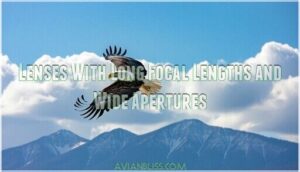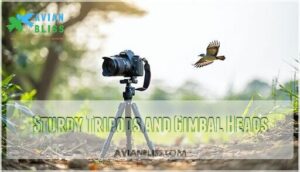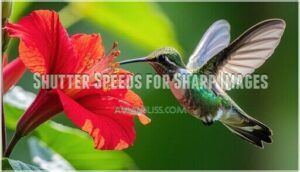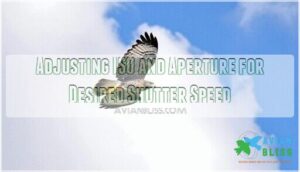This site is supported by our readers. We may earn a commission, at no cost to you, if you purchase through links.
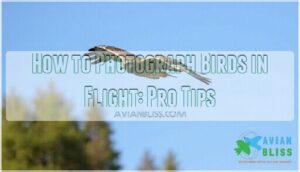
Set your camera to burst mode and slightly stop down your aperture for better depth of field. Position yourself with the sun at your back for ideal lighting.
Use a telephoto lens (300mm minimum) and hold steady or mount on a tripod. Track your subject before it takes off, following through like a tennis player after the shot.
Study bird behavior to anticipate flight patterns and practice on larger, slower species first. The difference between an average shot and a frame-worthy masterpiece often comes down to your field preparation.
Table Of Contents
- Key Takeaways
- Pick The Best Location
- Shoot During The Best Light
- Prepare The Right Gear
- Study Your Subject
- Master Camera Settings
- Master Autofocus Techniques
- Optimize Your Shot
- Work With Contrasting Backgrounds
- Start With Slow-Flying Birds
- Aim for Powerful Composition
- Frequently Asked Questions (FAQs)
- How to take pictures of birds in flight?
- What are the best camera settings for birds in flight?
- How to capture a bird in flight?
- What shutter speed and ISO for birds in flight?
- What is bird in flight photography?
- How to photograph birds in flight?
- How do I make a good bird photo?
- Do you need a camera to photograph birds in flight?
- How do you capture birds in flight?
- How to shoot birds in flight with a camera?
- Conclusion
Key Takeaways
- You’ll need fast shutter speeds (1/1000s or faster) and the right gear, including a telephoto lens (300mm minimum) and a camera with continuous autofocus and burst mode.
- You should position yourself with the sun at your back during golden hour and choose locations with clean, contrasting backgrounds that make birds stand out.
- You’ll capture better images by understanding bird behavior and flight patterns, which helps you anticipate movement and be ready when birds take flight.
- You’ll improve your success rate by starting with slower-flying species like herons or egrets before attempting to photograph faster birds, and by using the rule of thirds to create dynamic compositions.
Pick The Best Location
You’ll want to pick a location with abundant food sources, like rivers or lakes, to increase your chances of capturing birds in flight.
By choosing the right spot, you’ll have access to varied angles and backgrounds, making your photos more interesting and dynamic, with abundant food sources.
Areas With Abundant Food Sources
You’ll find many birds near river habitats and lake ecosystems, as they offer abundant food sources.
Look for flowering bushes and areas with local wildlife, using parks services for insights, to capture stunning birds in flight photos with valuable bird photography tips on understanding bird behavior and their food source, and apply bird photography techniques effectively.
Birding Hotspots and Forums
You’re looking to elevate your bird photography game.
To do so, tap into local hotspots and forums for insider knowledge.
- Join regional birding groups for migration updates
- Check eBird maps for species-rich locations
- Follow wildlife photographers on Instagram
- Connect with local Audubon chapters for guided outings, considering forum etiquette and species rarity when planning your trip and sharing locations for capturing stunning birds in flight.
Positions With a Direct, Dead-Ahead Angle
You’ll capture stunning bird in flight photos with a direct, dead-ahead angle, showcasing symmetry and wingspan.
Tracking bird flight paths helps you anticipate and frame the perfect head-on focus, creating beautiful background blur from the birds perspective, which emphasizes the importance of wingspan.
Access to Varied Angles and Backgrounds
To master bird photography, consider these 4 tips:
- Elevated Perspectives
- Unique Vantage
- Water Reflections
- Open Skies.
You’ll discover new ways to shoot birds in flight from different angles, adding depth to your photos.
Ground level or above, experiment with various vantage points for stunning flight photography.
Consider visiting coastal birding hotspots to enhance your opportunities for capturing great moments.
Shoot During The Best Light
You’ll get the best shots when you shoot during the golden hour, with soft, flattering light that brings out the details of the birds.
By shooting at the right time, you can avoid harsh light and capture stunning images of birds in flight with beautiful, warm tones.
Golden Hour Photography
You’re shooting birds in flight, so timing is key.
Golden hour offers soft shadows and warm tones, perfect for avian photography.
| Lighting | Effect |
|---|---|
| Golden light | Soft shadows |
| Soft light | Warm tones |
Use golden hours for stunning bird photography results.
Soft, Flattering Light Conditions
During golden hour, you’ll often get soft, diffused light on cloudy days.
This even illumination minimizes harsh shadows, creating a flattering glow for avian photography, keeping birds front-lit and avoiding glare for stunning bird in flight shots with perfect light direction, which results in stunning bird images.
Avoiding Harsh and Dismal Light
To avoid harsh light, prioritize softer moments.
Consider these tips:
- Use diffused light
- Avoid midday sun
- Leverage cloudy days
Play with shadow for interesting effects, enhancing your bird in flight photos with better lighting.
Experimenting With Unique Lighting Effects
Now, let’s get creative with lighting effects! Forget harsh light. Instead, wait for the magic of sunrise or sunset.
Try these for unique flight photography:
- Backlighting techniques for dramatic silhouette shots.
- Using reflective surfaces like water.
- Experimenting with creative filters.
- Light painting during twilight for surreal effects.
Capture that bird in flight during golden hours. Nail your exposure, and you’ll get breathtaking images.
Prepare The Right Gear
You’ll need to prepare the right gear to capture stunning bird-in-flight photos, including a modern DSLR or mirrorless camera and lenses with long focal lengths.
By choosing the right equipment, such as sturdy tripods and gimbal heads, you’ll be well on your way to taking sharp, high-quality images of birds in flight.
Modern DSLR or Mirrorless Cameras
You’ll need a modern DSLR or mirrorless camera with a good sensor size, high megapixel count, and image stabilization for excellent bird photography, especially for capturing birds in flight with fast autofocus settings and swift shutter speed.
Many photographers invest in DSLR bird photography to improve their results, which can include using cameras with fast autofocus settings and swift shutter speed for better image quality.
Lenses With Long Focal Lengths and Wide Apertures
For bird photography, choose a telephoto lens with a long focal length and wide maximum aperture.
- Focal Length Choice
- Aperture Sweet Spot
- Sharp optics
ensure a great shot with bokeh quality and lens stabilization.
Many photographers seek to buy equipment here for this purpose.
Sturdy Tripods and Gimbal Heads
You’ll benefit from a sturdy tripod and gimbal head for smooth bird photography.
Tripod materials and head stability are key.
Gimbal benefits include effortless tracking and lens stabilization, making it ideal for telephoto lens use, and there are budget options available.
Consider tripod gimbal options for enhanced stability.
Camouflage Clothing and Blinds
You’ll want concealment effectiveness for bird photography.
Consider camouflage clothing and blind types, selecting patterns that blend in. Prioritize scent control and ethical considerations to get close without scaring birds, enhancing your bird photography experience with the right equipment.
Effective camouflage relies on cryptic coloration techniques to blend seamlessly with the environment.
Study Your Subject
You’ll need to understand bird biology and behavior to capture great flight shots.
By studying your subject, you’ll learn to anticipate and prepare for their movements, making it easier to get the perfect photo.
Bird Biology and Behavior
To truly nail bird photography, you’ve got to think like a bird. Knowing their secrets gives you a huge advantage.
Delve into bird biology and behavioral habits, focusing on migration patterns, nesting habits, and feeding strategies. Understand their unique bird flight patterns, like soaring or flapping. This is key for amazing shots.
Here’s what you should watch for:
- Social structures: Capture birds flirting or even fighting.
- Mating rituals: Catch unique displays.
- Habitat choices: Position yourself where food’s abundant.
- Witness the dance of life.
- Capture fleeting moments of connection.
- Preserve the beauty of nature.
Dig into their world, and watch your bird photographs take flight.
Observing Daily Rhythms and Schedules
You’ll uncover bird behavior secrets by observing nesting patterns, feeding times, and migration schedules, revealing predictable movements and habits.
Like mating rituals and roosting behavior, to anticipate bird flight patterns and movements.
Identifying Predictable Entrance and Exit Points
You’ll find birds favor certain nest locations and feeding routes, like commuters.
Understanding these flight patterns through nest observation and habitat analysis helps predict their movements, making it easier to capture birds in flight and master bird photography by identifying predictable entrance and exit points, which is crucial for bird photography.
Understanding Aggressive Behavior in Birds
Ever wondered why a bird might act like a tiny feathered bouncer? Understanding what ticks them off is key for ethical bird photography.
You’ll face bird photography challenges if you don’t.
Here’s what you should know:
- Nest defense: Birds dive when you’re near nests.
- Territorial disputes: Watch skirmishes over space and food competition.
- Mating aggression: Some birds are more aggressive during brood protection.
Master Camera Settings
You’ll need to master your camera settings to capture stunning bird-in-flight photos.
By adjusting your aperture, ISO, and shutter speed, you can achieve sharp images with a beautiful background blur.
So let’s get started with the basics.
Aperture Priority Mode and Aperture Settings
Aperture Priority mode gives you direct control over your depth-of-field when capturing birds in flight.
Set your camera to "A" or "Av" mode and choose your aperture based on desired results.
For bird photography, f/5.6-f/8 offers the sharpness sweetspot—balancing detail and light sensitivity.
On bright days, f/8 provides enough sharpness for the entire bird while allowing decent shutter speeds.
In dim conditions, open up to f/4 or wider.
ISO Settings and Noise Reduction
ISO settings represent your noise threshold in bird photography. Finding the balance is essential for quality flight shots.
- Keep ISO at 200-400 for stationary birds in good light
- Increase to 800-1,000 for birds in flight when needed
- Consider your camera’s ISO invariance and sensor size
- Use post-processing tools like Topaz for high ISO noise reduction
Remember: lower ISO means cleaner images, but don’t sacrifice shutter speed for it.
Shutter Speeds for Sharp Images
Selecting the right shutter speed stands as the cornerstone of freezing birds in flight. For tack-sharp bird photography, maintain speeds of at least 1/1000s, preferably 1/2000s or faster for smaller, quicker species.
- Adjust to 1/2500s minimum for hummingbirds and small songbirds
- Use 1/1000-1/1600s for larger birds like hawks or herons
- Try 1/125-1/250s with panning techniques for artistic motion blur
Adjusting ISO and Aperture for Desired Shutter Speed
Balancing the exposure triangle is essential for birds in flight photography.
To maintain fast shutter speeds, the following settings can be used:
In Manual Mode, start with f/8 for sharpness, then adjust ISO to keep noise minimal while maintaining quick shutter speeds.
When light fades, open your aperture before pushing ISO higher to ensure the best possible image quality with fast shutter speeds.
Master Autofocus Techniques
You’ll need to master your camera’s autofocus system to capture sharp images of birds in flight, focusing on techniques like continuous AF mode and strategic focus point selection.
Properly configured autofocus settings will dramatically increase your keeper rate, letting you track fast-moving subjects against various backgrounds without losing critical focus on those magnificent wings in motion, utilizing autofocus settings and emphasizing sharp images.
Favorable Wind and Sun Conditions
When shooting birds in flight, both wind direction and sun angle dramatically impact your success rate.
Position yourself with the sun at your back during golden hour for superior light quality that highlights feather detail.
Birds typically fly into the wind, so standing with wind at your back helps you capture their approach.
This positioning creates front-lit subjects with clean flight paths.
Weather patterns matter too—slight overcast diffuses harsh light while maintaining good exposure.
On sunny days, morning and evening light produces warm tones that make your bird photography truly stand out.
Predictable Flight Paths and Clean Backgrounds
While perfect wind and sun are essential, finding predictable flight paths is equally important.
Birds often follow consistent routes, especially near nests. Watch for these patterns to position yourself strategically.
Clean backgrounds dramatically improve your autofocus performance. Look for:
- Routes birds take between feeding areas
- Regular perch-to-perch flights around territories
- Nest approaches for cavity-nesting species
- Morning and evening commuting patterns.
Background selection can make or break your flight photography success.
Distance and Autofocus Performance
The relationship between distance and autofocus performance is vital for bird photography success.
Your telephoto lens needs adequate distance for proper focus—longer lenses like 500mm require more space.
Clean backgrounds substantially improve focus tracking, while cluttered scenes confuse your camera’s autofocus system.
When photographing smaller birds, select precise focus points and faster tracking settings.
For larger subjects, your lens’s aperture affects autofocus speed.
Remember to prefocus your lens when possible for quicker subject acquisition.
Continuous Focusing and Shutter Release Techniques
Mastering continuous focusing transforms your flight photography success rate.
When birds zip across your viewfinder:
- Set your camera to continuous focusing mode (AI Servo/AF-C) to track movement without interruption
- Use "bump focusing" by tapping the focus button intermittently until your bird approaches, then hold for precise tracking
- Adopt an athletic stance with legs slightly apart and elbows tucked for stability during panning
Customize tracking sensitivity based on your background complexity.
Practice burst shooting in short, controlled sequences rather than holding down the shutter endlessly.
Your keeper rate will soar when these techniques become second nature.
Optimize Your Shot
You’ll need to position your body correctly and frame your subject thoughtfully to capture stunning birds in flight.
Apply the rule of thirds by placing the bird off-center and leave more space in the direction it’s flying for a balanced, professional-looking photograph.
Positioning Yourself for Optimal Flight Photography
With autofocus mastered, your physical positioning becomes essential for stunning flight shots.
Position yourself with the sun and wind at your back for ideal lighting on birds’ features. Select a comfortable vantage point that offers clear views of typical flight paths.
Choose locations with uncluttered backgrounds to make your subject pop. Use natural hiding techniques like existing vegetation to avoid disturbing birds, maintaining ethical considerations while capturing their natural movements.
Utilizing The Rule of Thirds and Space
Now that you’re positioned correctly, let’s frame your shot perfectly.
The rule of thirds transforms your bird photos by placing the subject at power points in your frame.
Leave more space (2-3 times) in front of where the bird is flying or looking. This negative space creates dynamic tension and showcases the bird’s movement.
For dramatic effect, try creative cropping that maintains balance while highlighting action. Utilizing techniques like leading lines adds depth and guides the viewer’s eye.
Capturing Multiple Birds in Flight
Moving beyond single-subject framing, you’ll find capturing multiple birds in flight creates stunning visual stories about flock dynamics and bird interactions.
When photographing groups of birds, your tracking focus needs to work overtime. Use burst mode to increase your chances of capturing that perfect formation flying moment.
- Look for natural compositional balance where birds create geometric patterns
- Wait for synchronized movement like turning or diving together
- Position yourself where you can predict flock flight paths
- Anticipate bird interactions like feeding, mating displays, or territorial disputes
By following these tips, you can improve your chances of capturing the perfect shot, and create a compelling visual narrative about the behavior and social interactions of birds in flight, highlighting their natural behavior.
Experimenting With Different Points of View
Beyond capturing multiple birds, your viewpoint dramatically changes your photos’ impact.
Experiment with different angles to tell unique stories:
| Viewpoint | Benefit | Effect on Image | Best for | When to Use |
|---|---|---|---|---|
| Eye-level | Intimacy | Direct connection | Portrait shots | Clear backgrounds |
| High-angle | Context | Shows environment | Flocks | Open spaces |
| Low-angle | Drama | Heroic silhouettes | Large birds | Clear skies |
| Bird’s perspective | Uniqueness | Fresh interpretation | Creative work | Elevated positions |
| Side-angle | Depth | Shows wing details | Action shots | Predictable paths |
You’ll be amazed how a simple position change transforms ordinary flight shots into stunning compositions.
Work With Contrasting Backgrounds
You’ll capture more striking bird images when you position your subject against backgrounds that make their colors and details stand out clearly.
A sky that contrasts with your bird’s plumage will make it pop in your photos, while proper metering guarantees your flying subject remains perfectly exposed against changing backgrounds, ensuring the bird’s image is well-defined with proper exposure.
Identifying Clean and Distant Backgrounds
Now that you’ve mastered ideal shooting positions, let’s focus on backgrounds that make your birds truly stand out.
Clean, distant backgrounds are essential for professional bird photography.
They create subject isolation and enhance your image’s impact through:
- Color contrast – Sky blues against colorful plumage create stunning visual impact
- Background blur – Greater distance increases natural bokeh with your telephoto lens
- Depth perception – Clean backgrounds improve the three-dimensional feel of your shots
Choose vantage points facing open sky or distant treelines rather than cluttered branches.
Using quality glass guarantees bright, clear images.
Metering The Sky and Adjusting Exposure
Photographers face a unique challenge when metering the sky for birds in flight.
Point your camera’s light meter toward the sky, then adjust exposure compensation up by 1-2 stops to prevent silhouetted birds.
Check your histogram to verify you’re capturing both highlight and shadow detail.
For consistently bright skies, use manual mode settings to maintain proper exposure as you track different species across varying backgrounds.
Shooting Against White or Busy Backgrounds
After metering the sky properly, you’ll need to tackle white or busy backgrounds effectively.
White skies and cluttered backgrounds can make bird photography challenging. Here’s how to handle them:
- Use exposure compensation (+1 to +2) to prevent birds from becoming silhouettes
- Switch between metering modes based on background complexity
- Create background separation with wider apertures (f/4-f/5.6)
- Employ subject isolation techniques by shooting from lower angles
- Consider post-processing tools to enhance contrast when tracking birds
Don’t get discouraged by challenging backgrounds—they’ll help you develop stronger bird photography skills.
Start With Slow-Flying Birds
You’ll master flight photography faster by starting with slow-flying birds like herons or pelicans that give you time to practice tracking and focusing techniques.
As you build confidence with these easier subjects, you can gradually move on to capturing swifts and swallows that test your newly developed skills.
Identifying Species With Slower Flight Speeds
When starting bird photography, focus on slower species for easier shots.
Birds of prey, herons, and storks offer ideal practice with their measured flight patterns.
These larger birds typically have slower cruising speeds, with raptors often utilizing thermal soaring.
Herons move deliberately, especially when traversing vegetation.
Pay attention to bird size, wing shape, and habitat clues—species’ flight speeds correlate strongly with their phylogenetic group, accounting for 55% of variation.
Practicing Autofocus Techniques on Slow-Flying Birds
Like learning to drive on an empty road, practicing autofocus techniques on slow-flying birds builds essential skills without overwhelming pressure.
Herons and egrets offer perfect targets for mastering tracking sensitivity and focus point selection.
Set your camera to continuous autofocus (AI Servo/AF-C) and practice the "bump focus" technique by intermittently pressing the autofocus button.
Adopt an athletic stance for stability, prefocus to an estimated distance, and experiment with different tracking AF area modes. You’ll develop muscle memory and confidence before tackling speedier subjects.
Gradually Moving to Faster-Flying Species
After mastering slow-flyers, challenge yourself with faster species.
Start with medium-paced birds like herons before attempting swifts or falcons.
Increase your shutter speed to 1/2500s or faster and use burst mode mastery to capture decisive moments.
Adjust your autofocus settings for enhanced tracking performance.
Remember that each challenging condition improves your skills—you’ll notice your bird photography substantially improving with each flight session.
Aim for Powerful Composition
You’ll need to position birds using the rule of thirds, leaving more space in the direction they’re flying for balanced, dynamic images.
Frame your subject carefully by placing it slightly off-center, which creates visual tension and guides the viewer’s eye through your photograph, using the rule of thirds.
Creating Custom Settings for Flight Photography
After mastering slow-flying birds, it’s time to optimize your camera’s brain for flight photography.
Create a Custom Mode on your camera specifically for birds in flight. Set your shutter speed to at least 1/1000s to freeze action, and configure Back-Button Focus for better control.
Select appropriate Metering Modes based on lighting conditions, and use continuous Drive Mode for rapid sequences. Adjust IBIS Settings or turn off stabilization when using fast shutter speeds.
Fine-tune your autofocus settings with expanded focus points—this simple customization will dramatically improve your bird photography success rate.
Adjusting Tracking Sensitivity and Autofocus Performance
Fine-tuning your autofocus tracking sensitivity is essential for bird in flight photography.
Decrease it to -2 for complex backgrounds to maintain focus lock. Apply focus point patterns like Group-Area AF (Nikon) or Zone AF (Canon) for better bird tracking.
Set Accel/Decel Tracking to +2 and AF Pt Auto Switching to +2 for ideal autofocus performance. These adjustments help your camera maintain lock on rapidly moving subjects against varying backdrops.
Capturing Dynamic and Engaging Images
Now that you’ve fine-tuned your tracking sensitivity, it’s time to create images that truly stand out.
Capturing dynamic and engaging bird flight photos requires both technical skill and artistic vision.
Here’s how to transform good shots into spectacular ones:
- Experiment with creative cropping to emphasize wing positions and aerodynamic forms
- Try unique perspectives like shooting from below against a blue sky
- Use motion blur techniques through panning to convey speed
- Include storytelling elements like prey capture or landing moments
These approaches will give your bird in flight photography emotional impact that resonates with viewers.
Remember, wildlife photography isn’t just about technical perfection—it’s about capturing moments that feel alive.
Frequently Asked Questions (FAQs)
How to take pictures of birds in flight?
Capturing birds in flight isn’t as hard as you think.
Use fast shutter speeds (1/1000s+), shoot during golden hours, prefocus where birds will fly, and maintain a stable stance while following their movement.
What are the best camera settings for birds in flight?
Use shutter priority mode (Tv/S) with speeds of 1/1000s minimum (1/2000s+ is better).
Set your aperture to f/6-f/8 and keep ISO as low as possible while maintaining fast shutter speeds.
How to capture a bird in flight?
Set your camera to fast shutter speeds (1/2000+), use continuous autofocus, and position yourself with the sun behind you.
Track the bird’s movement with your whole body, and shoot in bursts when it enters frame.
What shutter speed and ISO for birds in flight?
Swift as the wind, you’ll need a minimum shutter speed of 1/1000s (preferably 1/2000s+) to freeze motion.
Keep ISO low (100) for quality, raising only when necessary to maintain your fast shutter.
What is bird in flight photography?
Bird in flight photography captures avian subjects while they’re airborne.
You’ll focus on freezing motion with fast shutter speeds, tracking movement precisely, and showcasing the dynamic beauty of birds during their natural flight behaviors, which involves dynamic beauty.
How to photograph birds in flight?
Grab your daguerreotype and prepare for action!
You’ll need fast shutter speeds (1/1000+), long lenses (300mm+), proper lighting, and knowledge of bird behavior.
Position yourself with the sun behind you during golden hours.
How do I make a good bird photo?
To make a good bird photo, use a telephoto lens and shoot during golden hours.
Position with the sun behind you, keep shutter speed above 1/1000s.
Frame your subject using the rule of thirds.
Do you need a camera to photograph birds in flight?
Yes, you’ll absolutely need a camera to photograph birds in flight.
A DSLR or mirrorless camera with fast autofocus, high burst rate, and telephoto lens (300mm+) will give you the best results.
How do you capture birds in flight?
You’ll need fast shutter speeds (1/1000s+), a telephoto lens, and proper stance.
Position with the sun behind you during golden hours, track birds with your whole body, and shoot in continuous bursts.
How to shoot birds in flight with a camera?
With wings spread against the golden sky, birds transform into art.
Use a fast shutter speed (1/1000s+), telephoto lens, and continuous autofocus.
Position yourself with the sun at your back during early morning hours.
Conclusion
Did you know that over 90% of professional bird photographers spend hundreds of hours practicing before capturing their first magazine-worthy shot?
Mastering how to photograph birds in flight requires patience, preparation, and persistence.
Remember to optimize your gear, understand your subjects, and position yourself strategically.
With consistent practice and these technical guidelines, you’ll soon transform from capturing blurry shapes to freezing breathtaking moments of avian aerobatics.
So grab your camera, head outside, and start creating your own stunning portfolio.




